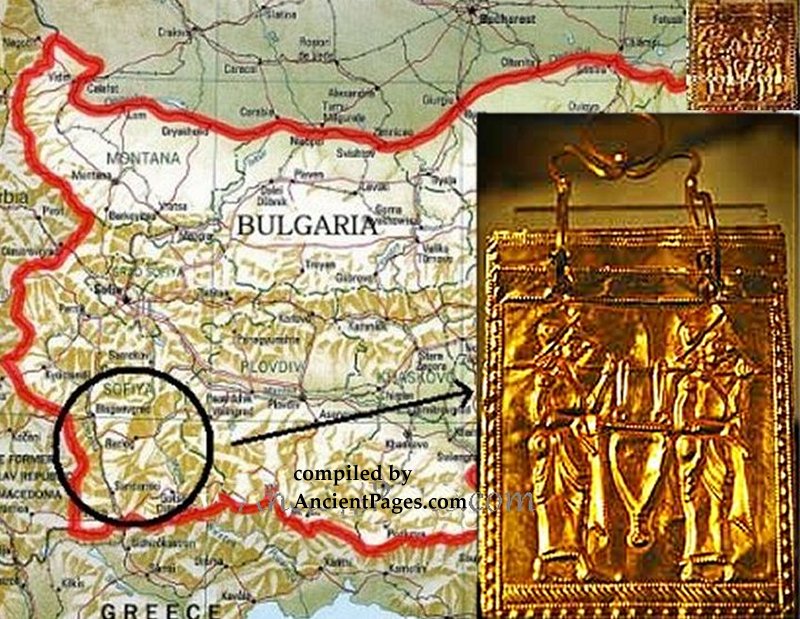A. Sutherland - AncientPages.com - More than sixty years ago, a unique discovery was accidentally made in the Valley of Struma River, the river in western Bulgaria, during road construction works.
A small book was found in an old tomb covered with frescoes. It is the world's oldest book in the history of humankind, made of gold and dated to 600 BC.
The illustrated six golden pages are made of 23.82-karat gold (measuring 5 centimeters in length and 4.5 centimeters in width) and fastened together with gold rings. The pages are covered with text and decorated with images of warriors, a horseman, a Siren, and a lyre.
Two independent experts from Bulgaria and England confirmed the book's authenticity.
According to researchers from the National Museum of History in Sofia, Bulgaria, the six sheets are believed to be the oldest comprehensive work involving multiple pages. The expert said, "there are about 30 similar pages known in the world, but they are not linked together in a book".
This precious work was written in the Etruscan language that belonged to the Etruscans, one of Europe's most mysterious ancient peoples, who are believed to have migrated from Lydia in modern western Turkey, settling in northern and central Italy nearly 3,000 years ago.
The Ancient Thracian Golden Orphism book, discovered in 1955, in the Struma River valley, in Bulgaria. It is exposed in the National history museum in Sofia. Image credit: Ivorrusev - CC BY-SA 4.0
They were wiped out by the conquering Romans in the fourth century BC, leaving few written records.
The real problem with deciphering Etruscan language lies in understanding the exact meanings of the words and grammatical forms. The language cannot be related to any other known language, living or dead.
The Etruscan language has already been deciphered, but most Etruscan texts remain obscure. The language had regrettably lapsed into oblivion, and today no one can read this over 2,5 thousand years old book.
However, the unique artifact can be seen at the National Museum of History in Sofia, Bulgaria, where it was placed on public display.
The world's oldest printed book was produced in China in 868 AD.
The artifact was discovered, along with other printed manuscripts, in a walled-up cave in Dunhuang ("blazing beacon") in Jiuquan of Northwest China's Gansu province in 1907. Dunhuang is a city in northwestern China, on the edge of the Taklamakan desert of Central Asia.
It has long been an important stop along the Silk Road, first established in the Han dynasty (207 BCE–220 CE). Trade on the Silk Road that passed through Dunhuang was a major factor in the development of civilizations in China, the Indian subcontinent, Persia, Europe, Africa, and Arabia
The place, probably the most famous and prominent Buddhist cave temple complex in the world, is renowned for its numerous caves decorated with beautiful frescoes.
The cave complex at Dunhuang forms one of the world's largest repositories of Buddhist art, with 45,000 square meters of paintings preserved in the 492 remaining caves.
It was discovered by the Hungarian-born archaeologist and explorer Sir Marc Aurel Stein (1862-1943) during his second expedition in 1907. Sir Stein reached "The Caves of the Thousand Buddhas" at Dunhuang and met a Taoist priest and abbot of the ancient caves, who was the discoverer of the Dunhuang manuscripts.
Hungarian-born Marc Aurel Stein, a British archaeologist and explorer, reached Dunhuang in 1907 and bought several cases loaded with paintings, embroideries, and other artifacts.
He also purchased seven thousand complete manuscripts written in Chinese, Sanskrit, Sogdian, Tibetan, Runic Turki, and Uighur. Among these manuscripts were some of the world's oldest surviving Buddhist paintings, and the book is known as "Diamond Sutra" from 863 AD.
"Diamond Sutra" is a scroll of seven strips of grey paper printed with Chinese characters and joined together around a wooden pole. The first sheet of the book, cut with great skill, is decorated with an illustration.
The scroll, which is about 17 and a half feet long and ten and a half inches wide, has the following inscription: "reverently made for universal free distribution by Wang Jie on behalf of his parents on the fifteenth of the fourth moon of the ninth year of Xian Long (May 11, 868)".
The book teaches the practice of the avoidance of extremes of mental attachment. The reader gets help to overcome human prejudices and limited perception of reality.
"Diamond Sutra" - now recognized as one of the world's great literary jewels, has recently undergone conservation. Unfortunately, it's too fragile to go on permanent display.
Written by A. Sutherland – AncientPages.com Senior Staff Writer
Updated on February 3, 2023
Copyright © AncientPages.com All rights reserved. This material may not be published, broadcast, rewritten or redistributed in whole or part without the express written permission of AncientPages.com
Expand for references








